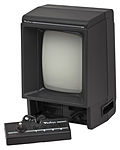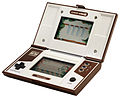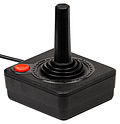History of video game consoles (second generation)
| Part of a series on: |
| History of video games |
|---|
The second generation of video game consoles began in 1976. The second generation began with the release of the Fairchild Channel F and Radofin Electronics' 1292 Advanced Programmable Video System. This generation is sometimes called the "early 8-bit era". Many consoles were released in the second generation. The Atari 2600 was the most popular video game console for much of the second generation. Other consoles such as Intellivision, the Odyssey 2, and ColecoVision were also popular.
The second generation ended in 1984. This was because of the video game crash of 1983. As of 2004, the Atari 2600 has sold 30 million units.[1] As of 1990, the Intellivision had sold 3 million units.[2][3][4] As of April 1984, the ColecoVision had sold 2 million units.[5] As of 1977, the Fairchild Channel F had sold 250,000 units.[6]
Home systems
Comparison
| Name | Fairchild Channel F | Atari 2600 | Magnavox Odyssey² | Intellivision | Atari 5200 | ||||
|---|---|---|---|---|---|---|---|---|---|
| Manufacturer | Fairchild Semiconductor | Atari | Magnavox | Mattel | Atari | ||||
| Console | 
|

|

|

|

| ||||
| Launch prices | US$169.95 | US$199 | US$200
¥49,800 |
US$299 | US$270 | ||||
| Release date | US August 1976 | US October 1977
EU 1978 |
US 1978
EU December 1982 JP 1982 BRZ 1983 |
US 1979
EU 1982 JP 1982 |
US November 1982 | ||||
| Media | Cartridge | Cartridge and Cassette (Cassette available via special 3rd party attachment) | Cartridge | Cartridge | Cartridge | ||||
| Top-selling games | N/A | Pac-Man, 7 million (as of September 1, 2006)[7][8] | N/A | Astrosmash (1 million)[9] | N/A | ||||
| Backward compatibility | N/A | N/A | None | Atari 2600 games through the System Changer module
accessories (retail) |
N/A |
|
|
|
|
| CPU | Fairchild F8
1.79 MHz (PAL 2.00 MHz) |
MOS Technology 6507
1.19 MHz |
Intel 8048 8-bit microcontroller
1.79 MHz |
General Instrument CP1610
894.886 kHz |
Custom MOS 6502C
1.79 MHz (not a 65c02) | ||||
| Memory | 64 bytes, 2 kB VRAM (2×128×64 bits) | (within a MOS Technology RIOT chip): 128 bytes (additional RAM may be included in the game cartridges) | CPU-internal RAM: 64 bytes
Audio/video RAM: 128 bytes |
1456 bytes main RAM | 16 kB main RAM | ||||
| Video |
|
|
|
|
| ||||
| Audio | Mono audio with:
|
Mono | Mono audio with:
|
Mono audio with:
|
Mono audio with:
|
| Name | Vectrex | Arcadia 2001 | ColecoVision | Bally Astrocade |
|---|---|---|---|---|
| Manufacturer | General Consumer Electric and Milton Bradley | Emerson Radio Corporation | Coleco | Bally Technologies |
| Console | 
|

|

|

|
| Launch prices | US$199 | N/A | US$199 | N/A |
| Release date | US November 1982
EU May 1983 JP June 1983 |
US 1982 | US August 1982
EU May 1982 |
US 1977 |
| Media | Cartridge | Cartridge | Cartridge and Cassette, available with Expansion #3 | Cartridge and cassette/Floppy, available with ZGRASS unit |
| Top-selling games | N/A | N/A | Donkey Kong (pack-in) | N/A |
| Backward compatibility | N/A | N/A | Compatible with Atari 2600 Via Expansion #1 | N/A |
| Accessories (retail) |
|
N/A |
|
|
| CPU | Motorola 68A09
1.5 MHz |
Signetics 2650 CPU
3.58 MHz |
Zilog Z80A
3.58 MHz |
Zilog Z80
1.789 MHz |
| Memory | 1 kB main RAM | 512 bytes | 8 kB main RAM
16 kB VRAM |
4k (up to 64k with external modules in the expansion port) |
| Video | Built in vector CRT |
|
|
|
| Audio | Mono (built in speaker) | Mono audio with:
|
Mono audio with:
|
Mono audio with:
|
Handheld systems
The first handheld game console was the Microvision designed by Smith Engineering. It was distributed and sold by Milton-Bradley in 1979. It was the first handheld game console that could use different game cartridges. The Microvision had a small LCD display. There were only a few games that could be played with this system. It was discontinued two years later.
The Epoch Game Pocket Computer was released in Japan in 1984. The game system did not sell very well. Because of this, only five games were made for it. Nintendo's Game & Watch was more successful. It was very popular until it was discontinued in 1991.
List of handheld systems
Milton Bradley Microvision (Released in 1979)
Nintendo Game & Watch (Released 1980-1991)
Epoch Game Pocket Computer (Released in 1984)
Software
Popular games
History Of Video Game Consoles (second Generation) Media
An opened Fairchild Channel F ROM cartridge, illustrating the ROM chips mounted to a circuit board within the casing. The cartridges were inserted into the console via the exposed contacts on the top of the board.
An Atari 2600 game joystick controller
References
- ↑ "Atari VCS (Atari 2600)". A Brief History of Game Console Warfare. BusinessWeek. Archived from the original on 2014-07-15. Retrieved 2007-12-04.
- ↑ "Mattel Intellivision - 1980-1984". ClassicGaming. IGN. Archived from the original on 2013-10-17. Retrieved 2008-05-16.
- ↑ "Ask Hal: Frequently Asked Questions to the Blue Sky Rangers". Intellivision Productions. Archived from the original on 2017-09-20. Retrieved 2008-11-03.
- ↑ "playstaion 303". Archived from the original on 2018-10-09. Retrieved 2013-05-22.
- ↑ Coleco Industries sales report, PR Newswire, 1984-04-17,
'First quarter sales of ColecoVision were substantial, although much less that [sic] those for the year ago quarter,' Greenberg said in a prepared statement. He said the company has sold 2 million ColecoVision games since its introduction in 1982.
- ↑ Gareth R. Jones; Charles W.L. Hill (2007). Strategic management: an integrated approach (7th ed.). Boston: Houghton Mifflin. p. C-123. ISBN 978-0-618-73166-4. Retrieved 25 February 2012.
By this point, second-place Fairchild sold around 250,000 units of its system.
- ↑ Jeremy Reimer (2006-09-01). "EA's Madden 2007 sells briskly, but are games gaining on movies?". Ars Technica. Retrieved 2008-01-31.
- ↑ Kent, Steven (2001). The Ultimate History of Video Games. Three Rivers Press. ISBN 0-7615-3643-4.
- ↑ "Mattel Intellivision — 1980–1984". ClassicGaming. IGN. Archived from the original on 2013-10-17. Retrieved 2008-05-16.
Other websites
- The Dot Eaters: Pixel Boxes Archived 2007-12-11 at the Wayback Machine











